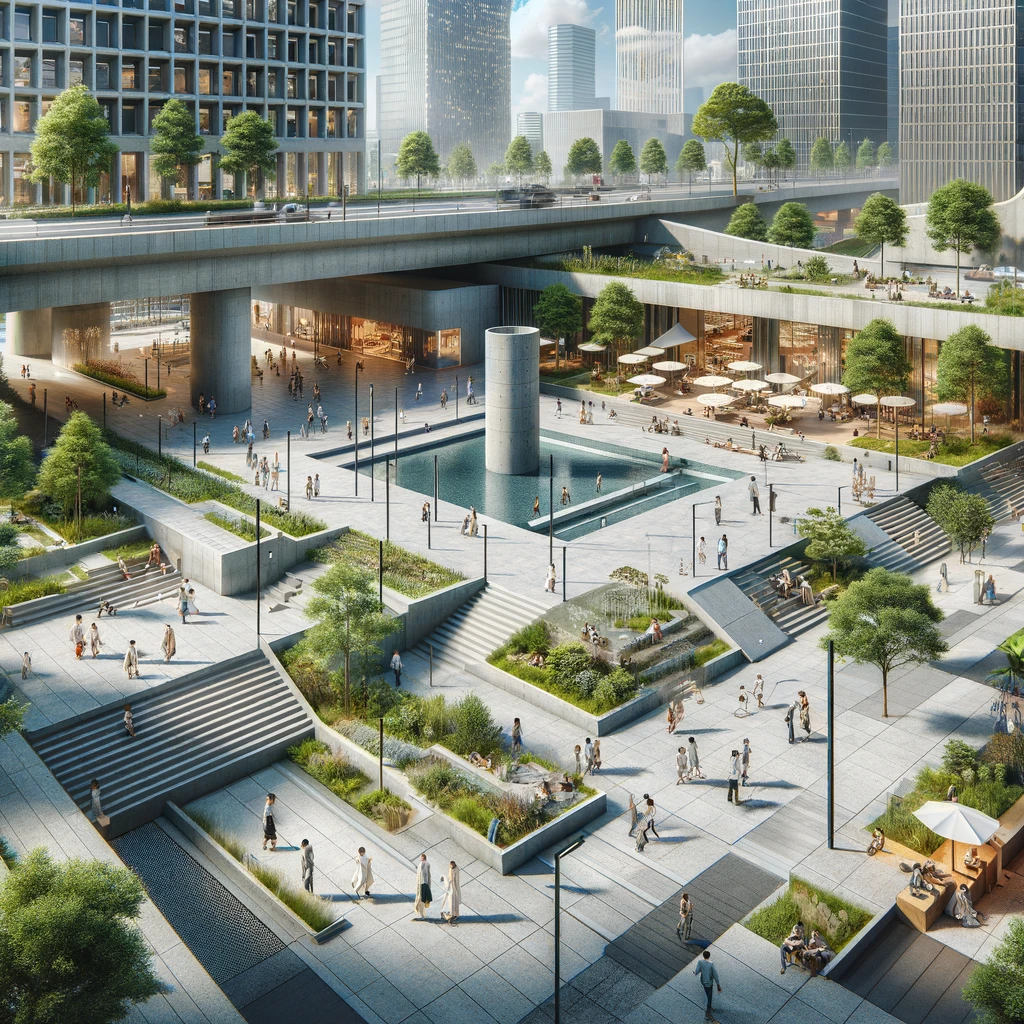Discover the vital role of concrete in shaping urban landscapes, from functional infrastructure to aesthetic design elements.
Concrete in Public Spaces
Explore how concrete is used in public spaces to create durable, functional, and aesthetically pleasing urban environments. From parks to pedestrian paths, concrete’s versatility is unmatched.
- Durability and Functionality:
Concrete’s robust nature makes it an ideal material for urban landscapes, enduring heavy foot traffic and varying weather conditions. It’s widely used in constructing sidewalks, plazas, and other public areas where longevity and low maintenance are crucial.
Beyond its durability, concrete plays a vital role in urban safety and accessibility. Its use in building ramps, curbs, and tactile paving ensures that urban environments are inclusive and navigable for all, including those with disabilities. Its adaptability to various shapes and forms allows for creative solutions in urban planning, ensuring that functionality goes hand in hand with aesthetic appeal.
- Aesthetic Flexibility:
Modern concrete technologies offer a range of textures, colors, and finishes, allowing urban designers to enhance the visual appeal of public spaces. Stamped concrete patterns and colored treatments transform plain surfaces into artistic elements.
The ability to mimic other materials like brick, stone, and even wood, while maintaining the strength and resilience of concrete, offers designers a palette for creativity. This versatility also allows for seamless integration with the natural environment, blurring the lines between urban infrastructure and the natural landscape, thus enriching the urban experience.
- Sustainable Practices:
Concrete’s role in urban landscaping is evolving with a focus on sustainability. The use of permeable concrete for effective water management and the incorporation of recycled materials are examples of eco-friendly practices in urban design.
Additionally, sustainable concrete solutions contribute to urban heat island mitigation. Light-colored concrete surfaces reflect more sunlight and absorb less heat, helping to moderate urban temperatures. As cities face the challenges of climate change, concrete’s role in sustainable urban landscaping becomes increasingly significant in building resilient urban ecosystems.

Innovative Concrete Solutions in Urban Design
Highlighting innovative applications of concrete that contribute to the functionality and aesthetic appeal of urban landscapes, such as artistic installations and eco-friendly designs.
- Artistic Installations:
Concrete is not just a structural element but also a medium for artistic expression in urban settings. Creative forms and installations add character and identity to cityscapes, making concrete a vital part of urban art and culture.
These artistic installations range from large-scale sculptures to intricate designs in public squares and parks, offering both aesthetic pleasure and community engagement. They often serve as landmarks and gathering spots, fostering a sense of community and cultural identity. The malleability of concrete allows artists and architects to push the boundaries of design, making each installation a unique testament to the creative potential of this versatile material.
- Eco-Friendly Urban Solutions:
The use of green concrete solutions in urban design reflects a commitment to environmental sustainability. Techniques like green roofing, urban gardens, and eco-friendly pavements contribute to creating greener, more livable cities.
These eco-friendly applications not only beautify urban areas but also play a crucial role in environmental conservation. Green roofs, for example, provide insulation, reduce stormwater runoff, and create habitats for wildlife. Urban gardens and parks with concrete elements contribute to air purification and provide essential green spaces in densely populated areas.
- Technology Integration:
Integrating technology into concrete applications, such as smart street lighting and interactive installations, is revolutionizing urban spaces. These innovations enhance both functionality and user experience in the modern cityscape.
Smart concrete technologies, like embedded sensors, can monitor traffic, structural health, and environmental conditions, providing valuable data for city planning and maintenance. Interactive concrete installations, such as light-emitting sidewalks and responsive public art, engage citizens and elevate the urban experience, showcasing how concrete can be a conduit for technological advancement in city living.
